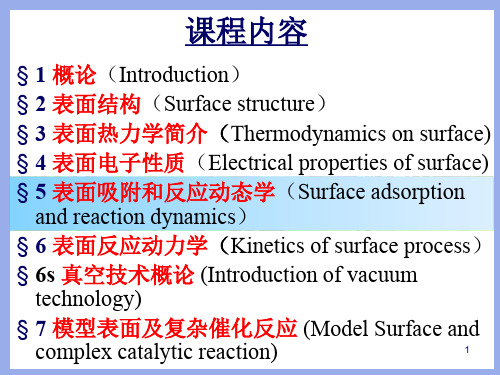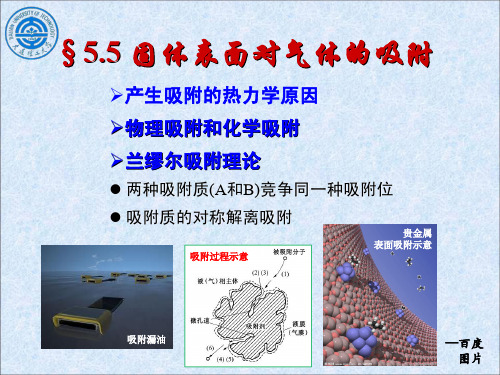表面物理化学-2015-5 第五章 表面吸附
表界面现象和吸附PPT课件

4. 弯曲液面上的饱和蒸气压
Kelvin公式: ln pr 2 M p0 RT r
意义: 表示同种液体的液滴和平面液体( r →∞)的饱和蒸气压与其曲率半径的 关系。
适用条件:温度、液体种类、密度和表面张力均不变。 应用: 人工降雨原理; 暴沸现象
32
第32页/共119页
液体沸腾时的过热现象
在 101.325 kPa、100℃的纯水中,离液面0.02 m的深 处,存在半径为10nm 的小气泡,此温度下纯水的表 面张力为 58.85mN·m-1,密度为 958.1kg·m-3,可算 出:
4πr2σ= 3.47×10-5J
: 将1g水分成半径为10-7 cm的小水滴时,小水滴的个数为
n
1
(4 r3 ) / 3
31 4 3.1416107
2.3871020
4πr2nσ=216 J
二者相差216J,即51.7cal
12
第12页/共119页
dG = -SdT + VdP + σdA
• 复习一下物理化学里的热力学基本方程,麦克斯维关系式,导数关系。 • 看课本P10页公式1-10等。
3
第3页/共119页
(b)气-固界面
4
第4页/共119页
(c)液-液界面
5
第5页/共119页
(d)液-固界面
6
第6页/共119页
(e) 固-固界面
7
第7页/共119页
(2) 界面现象
• 由于界面两侧的环境不同,因 此表面层的分子与液体内的分 子受力不同:
(1)液体内部分子的吸引力是对 称的,各个方向的引力彼此抵 销,总的受力效果是合力为零。
σT =σ0[1-K(T-T0)]
物理化学实验溶液的表面吸附实验数据、结论和实验报告

实验名称:溶液的表面吸附
实验目的:
用最大气泡压力法测同浓度的醇溶液的表面张力σ,作出σ-c曲线,并计算吸附量;作吸附量Γ对浓度c的曲线,找出最大吸附量Γ∞;掌握最大气泡压力法测定表面张力的原理和技术
实验原理:
当液体中加入溶质时,体表面张力发生变化,随着溶液的浓度变化不同,表面张力发生的变化也不相同。
附加压力与表面张力成正比,与气泡曲率半径成反比,此本实验采用最大气泡压力法测定不同浓度乙醇溶液的表面张力
操作步骤:
数据处理:
<第一部分>
由K=
σ
水
∆p水
,求出仪器常数K=-1.3254,记录室温25℃
根据上图可知该温度下最大吸附量Γ∞为60.5×10−11mol∙cm−2 <第二部分>
由K=
σ
水
∆p水
,求出仪器常数K=-1.3304,记录室温35℃
根据上图可知该温度下最大吸附量Γ∞为55.7×10−11mol∙cm−2
分析与讨论:
1.实验时,确保粗细两毛细管插入液面下的位置一致,且橡胶塞密封完好
2.鼓泡速率不能太快也不能太慢,适宜的速率为5-6秒产生一个气泡。
固体表面的吸附

固体表面的气体与液体有在固体表面自动聚 集,以求降低表面能的趋势。 固体表面的气体或液体的浓度高于其本体 浓度的现象,称为固体的表面吸附。 广泛的应用:
干燥剂、防毒面具、脱色剂、色谱、污水处 理、催化剂、…
Adsorbent (吸附剂) and adsorbate (吸附质)
当气体或蒸汽在固体表面被吸附时,固体称为
固体表面的特性
固体表面上的原子或分子与液体一样,受力 也是不均匀的,而且不像液体表面分子可以移动, 通常它们是定位的。 Solid Na Ag NaCl MgO 石蜡 聚乙烯 云母 γ/(mJ m-2) 200 800 190 1200 25.4 33.1 2400 大多数固体比液体具有更高的表面能
♦ Since the conc. is uniform throughout the material, absorption is a 'bulk phenomenon'. But adsorption is a 'surface phenomenon'.(conc. is higher in surface of adsorbent) ♦ Absorption occurs at uniform rate. Adsorption is rapid at the beginning ,but it's rate slowly decreases
• 2、在金属氧化物上CO的化学吸附 • 一氧化碳在金属氧化物上的吸附是不可逆的,一 氧化碳与金属离子是以σ 结合的 • IR:2200cm-1
• 四、烯烃的化学吸附态 在金属上烯烃的吸附态 • 烯烃在过渡金属表面既能发生缔合吸附也能发 生解离吸附。这主要取决于温度、氢的分压和 金属表面是束吸附氢等吸附条件。如乙烯在预 吸附氢的金属表面上发生σ型(如在Ni[111]面) 和π型(如在Pt[100]面两缔合吸附。
物理化学界面现象知识点

由此,对于多相系统有:
dU
, ,
(T ( ) ds ( ) p ( ) dV ( ) i dni dAS
i
同理,有界面相时的平衡判据与平衡条件 热平衡条件:
T ( ) T ( ) T ( ) T
( ) B ( )
其中 U ( )、H ( )、A ( )、G ( ) 为界面过剩热力学能、界面 过剩焓、界面过剩亥氏函数和界面过剩吉氏函数。他们都是 广延性质。
所以 X X ( ) X ( ) X ( ) 其中X为系统总的热力学性质 X ( )、X ( ) 为 相的体热力学性质
表面张力、单位面积的表面功、单位面积的表面吉布斯 函数三者的数值 、量纲等同,但它们有不同的物理意义,是 从不同角度说明同一问题。
与液体的表面张力类似,其它界面,如固体表面、液-液界 面、 液-固界面等由于界面层分子受力不对称,也同样存在界 面张力。
(2)表面热力学公式 对一般单相多组分体系,未考虑相界面面积时:
还有一类多孔固体,如多孔硅胶、分子筛、活性炭等,也 2 有很高的比表面。如活性炭比表面可达到 1000 ~ 2000 m /g。在 处理高分散度物质时,若不考虑其界面的特殊性,将会导致错 误的结论。本章将对界面的特殊性质及现象进行讨论与分析。
界面现象本质
表面层分子与内部分子相比,它们所处的环境不同。 体相内部分子所受四周邻近相同分子的作用力是对称的,各 个方向的力彼此抵销(各向同性); 但是处在界面层的分子,一方面受到体相内相同物质分子的 作用,另一方面受到性质不同的另一相中物质分子的作用,其作 用力不能相互抵销,因此,界面层分子由于其处在一不均匀对称 的力场会显示出一些独特的性质。 对于单组分体系,这种特性主要来自于同一物质在不同相中 的密度不同;对于多组分体系,则特性来自于界面层的组成与任 一相的组成均不相同。
物理化学实验报告-表面吸附

物理化学实验报告溶液表面吸附的测量1.实验目的(1)掌握最大气泡压力法测定溶液表面张力的方法。
(2)根据Gibbs 吸附方程式,计算溶质(乙醇)在单位溶液表面的吸附量Γ,并作Γ−c 图。
2.实验原理在定温下,纯物质液体的表面层与本体(内部)组成相同,根据能量最低原理,为降低体系的表面吉布斯自由能,将尽可能地收缩液体表面。
对溶液则不同,加入溶质后,溶剂表面张力发生变化。
根据能量最低原理,若溶质降低溶剂表面张力,c (表面层)> c (本体);反之,若溶质升高表面张力,c (表面层)<c (本体)。
溶质在溶液表面层与在溶液本体中浓度不同的现象称为溶液的表面吸附,即溶液借助于表面吸附来降低表面吉布斯自由能。
溶液表面吸附溶质的量Γ与表面张力σ、浓度c 有关,其关系符合Gibbs 吸附方程T cRT c )(∂∂-=Γσ式中:Γ吸附量;c 溶液浓度;T 温度;R 气体常数;σ表面张力或表面吉布斯自由能。
T c)(∂∂σ表示在一定温度下,表面张力随浓度的变化率。
如果溶液表面张力随浓度增加而减小,即(∂σ∂c )<0,Γ>0,此时溶液中溶质在表面层中的浓度大于在溶液中的浓度,称为正吸附。
相反,Γ<0,称为负吸附。
在一定温度下,测定不同浓度溶液的表面张力σ,以σ对c 作图,求不同浓度时的T c)(∂∂σ值。
由Gibbs 吸附方程求各浓度下的吸附量Γ。
对于求各点斜率值可以借助计算机软件。
测定液体表面张力的方法较多,如最大气泡压力法,滴体积法,毛细管升高法,环法等,本实验采用最大气泡压力法。
将待测液体装入表面张力仪中,使玻璃毛细管下端与液面相切,若液体能润湿管壁,则液体沿毛细管上升形成凹液面,其液面所受压力P ’为大气压力P 0和附加压力ΔP 。
根据拉普拉斯(Laplace )方程:∆P =2σr式中:r 为弯曲液面曲率半径;σ为液体与气体表面(界面)张力。
因是凹液面,弯曲液面的曲率半径r <0,ΔP <0(指向大气)。
表面物理化学

表面活性剂的一些重要作用及其应用
表面活性剂的用途极广,主要有五个方面:
3.增溶作用 非极性有机物在水中溶解度很小,
加入油酸钠等表面活性剂后,在水中的 溶解度大大增加,这称为增溶作用。
增溶作用与普通的溶解概念是不同的, 增溶的溶质不是均匀分散在水中,而是 分散在表面活性剂分子形成的胶束中。
经X射线衍射证实,增溶后各种胶束 都有不同程度的增大,而整个溶液的 的依数性变化不大。
吸附热 较小(~液化热)
较大
选择性 无选择性
有选择性
稳定性 不稳定,易解吸
稳定
分子层 单分子层或多分子层 单分子层
吸附速率 较快,
较慢.
受温度影响小
受温度影响大
液-固界面——润湿作用
粘湿过程 浸湿过程
铺展过程
§13.6 液-固界面—润湿作用
什么是润湿过程?
滴在固体表面上的少许液体,取代了部分固-气界面,
表面活性剂及其作用
表面活性剂分类 表面活性剂在水中的溶解度 表面活性剂的一些重要作用及其应用
表面活性剂的分类
阴离子型
离子型
阳离子型
表面活性剂
两性型
非离子型
表面活性剂在水中的溶解度
表面活性剂的亲水性越强,其在水中的溶解 度越大,而亲油性越强则越易溶于“油”
故表面活性剂的亲水亲油性也可以用溶解度 或与溶解度有关的性质来衡量
粘湿功的绝对值愈大,液体愈容
g lss
固
易粘湿固体,界面粘得愈牢
浸湿过程
在恒温恒压可逆情况下,将具有单位表面积的固体浸入液 体中,气-固界面转变为液-固界面的过程称为浸湿过程
该过程的Gibbs自 由能的变化值为:
G ls gs Wi
表面物理化学-2015-5 第五章 表面吸附

§ 1 概论(Introduction) § 2 表面结构(Surface structure) § 3 表面热力学简介(Thermodynamics on surface) § 4 表面电子性质(Electrical properties of surface) § 5 表面吸附和反应动态学(Surface adsorption and reaction dynamics) § 6 表面反应动力学(Kinetics of surface process) § 6s 真空技术概论 (Introduction of vacuum technology) § 7 模型表面及复杂催化反应 (Model Surface and 1 complex catalytic reaction)
Adsorption Enthalpy
Wide range (related to the chemical bond strength) -1 - typically 40 - 800 kJ mol
Often dissociative May be irreversible Limited to one monolayer Very variable - often an activated process
弱吸附分子之间的相互作用与衬底表面性质无关
重要应用:比表面的测量, 物理吸附方法 BET
7
T=60-99K, Xe<0.33 ML: commensurate √3x √3R30o
Phase transition
8
Comsa et al. physisorbed rare gas adlayer studied by He scattering
Nature of Adsorption Saturation Uptake Kinetics of Adsorption
高等物理化学(3)

n (1 x2 )
s 2
若n2足够大,则n2s约为常数 Γ
0
x2 →
1
2. 单个组分的吸附等温线(即求出n1s 和n2s )
(1) 实验法; 假设固体在溶液中的吸附量和在与溶液成平衡 的蒸汽中的吸附量相同
W n M1 n M 2
s 1 s 2
W:单位质量吸附剂吸附蒸汽 G 的总质量,可通过称量吸 附前后吸附剂的质量求得 L M1、 M2:组分1和组分2的分子 量 将此式与混合吸附等温式联立,即可求得n1s 和n2s
S n
s 2, 0
s2
s2 S
n
s 2, 0
代入(5)式
s n1s n2 s 1 s n1,0 n2,0
与表面过剩量公式联立,即可求出n1s,n2s
对微孔吸附剂
V n V n V
s 1 1
s 2 2
Vi : 液体组分i 的摩尔体积 V: 吸附剂的总孔体积
5-3 自稀溶液中的吸附 在稀溶液中,x2<<x1
b 2 1
xi : 平衡时溶液本体中组分 i的摩尔分数
将(1)、(2)式两边分别乘以x2和 x1,并将上式代入
b s n10 x2 n2 x1 m n 1 x2 0 b s n2 x1 n1 x2 m n2 x1
(3) (4)
b 2 1 0 2 1 0 1 2
(4)- (3) : m( x n x n ) (n x n x ) n x n x
设 固体与纯溶剂的界面张 力为 0 , 界面上铺满单分子层时 的界面张力为 m 则当界面上溶质分子的 覆盖率为 时 界面张力为
0 (1 ) m
n 0 ( 0 m ) - - - (1) n
物理化学5.5-1 固体表面的吸附-物理吸附和化学吸附

应用举例:
石油加工,气体纯化, 催化合成,污水处理, 空气净化(防毒面具), 空气的变压吸附分离, 洁净能源(储氢材料) 。
物理吸附和化学吸附
——按吸附作用力性质的不同区分
表5.6 物理吸附与化学吸附的区别
吸附性质
物理吸附
化学吸附
吸附力
分子间力
化学键力
吸附热
小
大
吸附分子层
单层或多层Байду номын сангаас
单层
吸附选择性
的途径(需能量ED)
容易的多。
Cu上氢的吸附势能曲线
无
有
脱附温度
低
高
吸附平衡/可逆性 易达到/可逆
不易达到/不可逆
用吸收光谱可鉴别物理吸附、化学吸附
——在紫外-可见-红外光谱区,出现新的特征吸收带,说明存在化学吸附。
温度可改变吸附力的性质 物理吸附(aa线)在一定条件下可转变为化学吸附(bb线) 。
从能量上看, 先发生物理吸附而 后转变为化学吸附 的途径(需能量 Ea), 要比氢分子先解离 成原子再化学吸附
§5.5 固体表面对气体的吸附
产生吸附的热力学原因
物理吸附和化学吸附
兰缪尔吸附理论
两种吸附质(A和B)竞争同一种吸附位
吸附质的对称解离吸附
吸附过程示意
贵金属 表面吸附示意吸附漏油— 图片产生表面现象的热力学原因
在定温、定压、定组成下,有
dGT , p,nB dAs <0
为使表面能降低,固体表面会自发地利用其未饱和 的自由价来捕获气相或液相中的分子,使之在固体表面 上浓集,这一现象称为固体对气体或液体的吸咐。
例如在罗丹明B的水溶液中加入一些活性炭,溶液的 颜色将逐渐变浅,说明RhB逐渐富集于活性炭表面。
固体表面的吸附与催化作用

固体表面的吸附与催化作用1. 引言固体表面的吸附与催化作用是物理化学中的重要概念。
在许多化学和工艺过程中,固体表面吸附和催化作用都发挥着至关重要的作用。
本文将探讨固体表面的吸附现象、催化机理以及它们在各种应用领域中的重要性。
2. 固体表面的吸附吸附是指气体、液体或溶液中的分子或离子附着在固体表面上的现象。
吸附可分为物理吸附和化学吸附两种类型。
2.1 物理吸附物理吸附也称为范德华吸附,是由于分子之间的范德华力相互作用引起的。
范德华力是一种短程力,主要由于分子之间的偶极-偶极相互作用或分子之间的诱导相互作用。
物理吸附通常发生在低温下,吸附量与温度呈反比关系。
2.2 化学吸附化学吸附是指气体或液体中的分子与固体表面上的活性位点形成化学键的过程。
化学吸附通常发生在高温下或在存在催化剂的情况下。
化学吸附是可逆的,并且在形成化学键的同时伴随着能量释放或吸收。
3. 固体表面的催化作用催化是指通过催化剂加速化学反应速率的过程。
固体表面上的催化作用是许多工业和生物过程中的关键步骤。
3.1 催化剂的种类常见的固体催化剂包括金属、金属氧化物和金属碱土(如钙、镁)等。
不同的催化剂对不同的反应具有不同的催化活性。
选择合适的催化剂对于提高反应的效率至关重要。
3.2 催化机理固体催化作用的机理主要包括表面吸附、反应和解离等过程。
在催化反应中,反应物吸附到催化剂表面上,形成中间体,然后通过反应形成产物。
催化剂能够提供活化能,降低反应的能量阻隔,从而加速反应速率。
4. 固体表面的吸附与催化在应用中的重要性4.1 催化剂在工业中的应用催化剂在许多化学工业过程中被广泛应用,例如氨合成、石油cracking、氧化反应等。
通过催化剂,可以提高反应速率、节省能源和原料,并减少副产物的生成。
4.2 固体表面的吸附在环境治理中的应用固体表面的吸附作用可以用于废水处理和空气污染控制中。
通过将污染物吸附到固体表面上,可以有效去除或降低污染物对环境的危害。
【最新精选】表面吸附量的测定

实验十九 表面吸附量的测定预习题1.为什么表面活性物质水溶液的表面张力随溶液浓度的变化而变化?2.用气泡最大压力法测表面张力时,为什么气泡必须均匀缓慢冒出?3.为什么毛细管端要刚好与液面接触?若毛细管端浸入溶液,则使最大压力差变大还使变小?为什么?4.毛细管常数如何测定?5.表面吸附量Γ的物理意义是什么?6.浓度为4.00×10-4 mol·L -1时的溶液表面吸附量如何得到?此表面吸附量的单位是什么?7.分析影响本实验结果的因素有哪些?一.实验目的1.用气泡最大压力法测定十六烷基三甲基溴化铵水溶液的表面张力。
从而计算溶液在某一浓度时表面吸附量Γ。
2.熟悉斜管压力计的使用方法。
二.实验原理1.在指定的温度下,纯液体的表面张力是一定的,一旦在液体中加入溶质成溶液时情况就不同了,溶液的表面张力不仅与温度有关,而且也与溶质的种类,溶液浓度有关。
这是由于溶液中部分分子进入到溶液表面,使表面层的分子组成也发生了改变,分子间引力起了变化,因此表面张力也随着改变,根据实验结果,加入溶质以后在表面张力发生改变的同时还发现溶液表面层的浓度与内部浓度有所差别,有些溶液表面层浓度大于溶液内部浓度,有些恰恰相反,这种现象称为溶液的表面吸附作用。
根据吉布斯吸附等温式12.303lg cd d RTdc RT d cσσΓ=-=- (1) 式中,Γ代表溶液浓度为c 时的表面上溶质的吸附量(mol·m -2),c 代表平衡时溶液浓度(mol·L -1),R 为理想气体常数(8.314 J·mol -1·K -1),T 为吸附时的温度(K )。
从(1)式可看出,在一定温度时,溶液表面吸附量与平衡时溶液浓度c 和表面张力随浓度变化率d dcσ成正比关系。
当0d dcσ<时,Γ > 0表示溶液表面张力随浓度增加而降低,则溶液表面发生正吸附,此时溶液表面层浓度大于溶液内部浓度。
第6课:表面吸附

化学吸附能随距离的变化
E. G. Wang
吸附高度 z0 ~ 1-3 Å 吸附能 EB ~ 1 eV
化学吸附可以在室温下稳定存在
物理吸附+化学吸附
E. G. Wang
zc Ep
Edes=EB+Eact
H2在金属表面的吸附
表面催化分解
化学吸附的基本过程
在吸附剂表面的化学吸附,以双原子气态分子为例, 大致分为三个步骤:
吸附的基本理论,多建立在平衡吸附的基础上。吸 附作用包括物理吸附和化学吸附两种类型。
表面吸附的一般描述
Physisorption
One-dimensional potential energy diagrams
(Z corresponds to the distance from the surface).
范德瓦尔斯作用能:u(R)
A R6
BБайду номын сангаасR12
Lennard-Jones 势
原子与固体表面间的范德瓦尔斯作用
表面外电荷e将诱导表面附 近的镜像电荷q:
对于金属表面, ε, q-e :
表面外的电荷会诱导表面附近的镜像电荷 E. G. Wang
表面上的范德瓦尔斯作用能
表面外电荷e与其镜像电荷的相互作用能 : 设:
拟合wang势起伏的空间尺寸径向积分的2dpowerspectrum长程势f和局域势d的空间尺寸2dpowerspectrum自相关函数傅立叶变换指数衰减形式lorentzian相关长度wang纳米尺度势起伏的物理本质纳米尺度势起伏并不是单个掺杂原子库伦势的简单叠加纳米尺度势起伏空间延展的长程势单个掺杂原子周围的局域屏蔽势电荷在能带中的fermidirac分布电子电子相互作用局域势长程势导带边能量分布小结
- 1、下载文档前请自行甄别文档内容的完整性,平台不提供额外的编辑、内容补充、找答案等附加服务。
- 2、"仅部分预览"的文档,不可在线预览部分如存在完整性等问题,可反馈申请退款(可完整预览的文档不适用该条件!)。
- 3、如文档侵犯您的权益,请联系客服反馈,我们会尽快为您处理(人工客服工作时间:9:00-18:30)。
Advantage and disadvantage
Also Xe-TDS
Wandelt Surface&Interface Analysis, 1988,12,15-20
9
化学吸附通常有独特的吸附位置和吸附构型
CO在fcc(111)上的吸附
C6H6 on Pt(111)
* Formation of surface –bound species, sub-surface species and even surface compounds during chemisorption.
Nature of Adsorption Saturation Uptake Kinetics of Adsorption
3
Physisorption:范德华力
T 足够低, 基本所有物质都会发生物理吸附(例外,吸附物 种-表面作用很强) 稀有气体,通常惰性,采用物理吸附,因为吸附物种-表面作用较弱
物理吸附:对吸附位置没有选择性,与表面相互作用较为平滑,吸附物
种之间作用与底物-吸附物种作用相当或更强
10
§ 5.2 Atoms and molecules incident on a surface
§ 5.2.1 Scattering channel
(1) elastic scattering:Es=Ei,有动量交换, s= i
Adsorption Enthalpy
Wide range (related to the chemical bond strength) -1 - typically 40 - 800 kJ mol
Often dissociative May be irreversible Limited to one monolayer Very variable - often an activated process
17
§ 5.2.4 Direct and precursor-mediated adsorption
The possibility of transient mobility for an adsorbing molecule brings with it two distinct types of adsorption dynamics in nonactivated adsorption:
(1)直接吸附( Direct adsorption):“一见钟情” 分子能量:
S较高 关系不大 E S下降 NO on Pt(111)
表面温度:与温度关系不大。高温时,无法区分脱附和散射。
(2)前驱态吸附(Precursor-mediated adsorption):法线方向能量损失,不 Metastable state 足以离开表面(“日久生情”)
课程内容
§ 1 概论(Introduction) § 2 表面结构(Surface structure) § 3 表面热力学简介(Thermodynamics on surface) § 4 表面电子性质(Electrical properties of surface) § 5 表面吸附和反应动态学(Surface adsorption and reaction dynamics) § 6 表面反应动力学(Kinetics of surface process) § 6s 真空技术概论 (Introduction of vacuum technology) § 7 模型表面及复杂催化反应 (Model Surface and 1 complex catalytic reaction)
13
s0 对气体-表面作用势非常敏感, 10-10~1
§ 5.2.2 Nonactivated adsorption
Lennard-Jones 势能表示 粒子的能量是气体吸附的决定因素之一。 L-J potential
ij 4 ij [(
ij r
) (
12
ij r
)6 ]
曲线为Ek=0时, 分子能量随分 子中心-表面之间距离的变化
与温度和能量关系较为复杂:多步骤过程;脱附?扩散到下一位置?吸附?
通常:Ts↗,S↘
例外:O2 on Pd(111): competition between desorption and dissociation
18
19
§ 5.3 吸附/脱附过程的微观可逆性
达到平衡时: 微观可逆性: if we reverse individual trajectories in space and time they must follow exactly the same trajectory. In the strictest sense, microscopic reversibility does not apply to molecule-surface interactions because of the symmetry of the problem. And a less form of reversibility, called reciprocity, is obeyed for molecule-surface interactions: gas-surface interactions exhibit time-reversal symmetry such that adsorption and desorption trajectories can be related one another.
PAX(photoemission of adsorbed Xe)
化学惰性但具有高度极化性能的Xe,可作为探针分子,表征表面结构和辨认表面不同位置
A: Xe on Ru B: Xe on Ag C: Xe on Ag/Ru
吸附Xe原子的EBF与衬底功函数呈线性变化,△ EBF(5P1/2)=- △
弱吸附分子之间的相互作用与衬底表面性质无关
重要应用:比表面的测量, 物理吸附方法 0.33 ML: commensurate √3x √3R30o
Phase transition
8
Comsa et al. physisorbed rare gas adlayer studied by He scattering
“反应坐标”
二维条件下原子的非活化解离吸附示意图
R轴:分子内原子相对运动(振动) Z轴:分子与表面之间相对运动
15
§ 5.2.3 活化吸附(Activated adsorption) 对活化吸附来说,
(a) 低动能: 无法越过势垒,s=0 随着动能的增加(大于活化势), s突然增加 (a) 高动能:s又开始下降
Related to factors like molecular mass and polarity -1 - typically 5-40 kJ mol (similar to heat of liquefaction)
Non-dissociative Reversible Multilayer uptake possible Fast - since it is a non-activated process
物理吸附中分子间相互作用起重要作用,通常与吸附物种-表 面相互作用相当
相对于化学吸附,没有特殊的吸附位置,非公度结构 (incommensurate structure)
4
CO adsorption on Au(110)
吸附与温度的关系:
T=77 K (LN2), 绝大多数物质吸附; T=4 K (LHe) 所有物质都吸附
Physisorption
Slight dependence upon substrate composition Virtually independent of surface atomic geometry Near or below the condensation point of the gas (e.g. Xe < 100 K, CO2 < 200 K)
如何区分活化吸附和非活化吸附?
测量 S(Ek)函数
16
early
middle
late
(a) early barrier: 势垒位于吸附入口:分子间 距与气相分子类似 (b) Late barrier: 势垒位于吸附出口:分子间 距拉长 The position of the barrier and the shape of the PES are decisive in determining how a molecule best surmounts the activation barrier.
5 J. M. Gottfried, et al. Surf Sci, 2003, 536(1-3): 206.
(1)物理吸附层的结构
• 气体分子在表面的停留时间: = 0 exp(△Hads/RT), 0 ~10-12 sec
若气体分子束单位时间撞击到单位表面的次数F(Flux),则
吸附分子的表面浓度(分子/cm2sec) 物理吸附的等温式 适用条件:(a)吸附粒子之间无相互作用(△Hads与覆盖度无关)
(b)表面能提供无限的吸附位置。
6
物理吸附在低覆盖度时的结构,取决于吸附质-衬底间和 吸附分子之间作用的大小。 例如, 惰性气体在金属表面的吸附为物理吸附
Xe/Pd(100) 低暴露量:无序吸附,功函数连续降低(Xe分子产生极 化)粘附几率不变 △Hads~7.5 kcal/mol 单层吸附后: “六方”超结构,功函数不变
He原子衍射:确定表面结构 ,类似 LEED (2) Direct inelastic scattering: Es=Ei ±△E,s≠ i,通常水平动量M∥不变 He原子散射:研究表面声子,吸附物种的低频振动和扩散. (3) Trapping/sticking: 表面捕获或吸附,差异在于表面停留时间(residence time) 角度分布以表面法向为中心,“记忆丧失”
